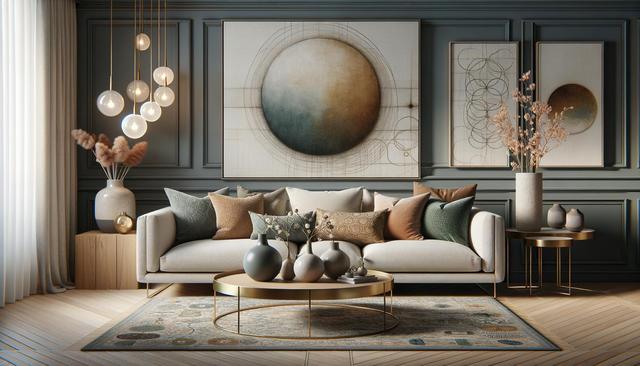Understanding the Role of Accessories in Interior Design
Interior design accessories are more than just decorative elements—they serve to personalize a space, enhance its aesthetic appeal, and bring functionality to the forefront. These items, which include rugs, throw pillows, art, lighting fixtures, and more, can help tie a room together by complementing the existing color palette and furniture arrangement. Accessories also allow flexibility in updating a room’s look without requiring a complete overhaul. Whether the goal is to create contrast, introduce texture, or add a sense of warmth, accessories are essential components in achieving a balanced design.
When selecting accessories, it’s important to consider the role each item will play. For instance, a large floor lamp may not only provide needed illumination but also serve as a sculptural focal point. Similarly, a well-placed mirror can enhance natural light and add depth to a small room. Accessories should contribute to the overall harmony of the space, aligning with both the practical needs and stylistic direction of the environment.
Choosing Accessories Based on Design Themes
Every interior design theme, from minimalist to bohemian, has accessories that support its unique aesthetic. Understanding how different themes influence accessory selection will help achieve a cohesive look. For example:
- In a minimalist setting, accessories are typically simple, functional, and limited in number. Think monochrome vases or sleek pendant lights.
- Scandinavian styles may include natural textures such as woven baskets, wool throws, and ceramic dishes in muted tones.
- For eclectic or bohemian interiors, layering is key—mixing patterns, colors, and materials through pillows, rugs, and wall art.
Matching accessories to your theme doesn’t mean sacrificing creativity. Often, a single standout piece can add character while still fitting within the broader design concept. By choosing items that reflect the core principles of your chosen style, you create a unified and inviting space.
Materials and Textures: Adding Depth and Interest
The materials and textures used in accessories play a major role in defining a room’s atmosphere. Accessories made from natural materials such as wood, jute, linen, or stone tend to bring warmth and softness, making them ideal for cozy, relaxed spaces. In contrast, metals like brass, chrome, or iron can convey a more modern or industrial feel.
Combining different textures can also prevent a design from feeling flat or monotonous. Consider layering:
- A plush wool rug over hardwood floors
- Velvet throw pillows against a leather sofa
- Glass vases on a reclaimed wood shelf
These combinations not only enhance visual appeal but also engage the senses, making a space feel more dynamic and lived-in. Thoughtful use of texture helps to create balance and adds subtle contrasts that contribute to the overall richness of the design.
Scale and Placement: Getting the Proportions Right
Even the most beautiful accessories can feel out of place if they’re not properly scaled or thoughtfully positioned. Size and placement are crucial to achieving a harmonious visual flow. Large items like floor lamps, oversized artwork, or area rugs should be balanced with supporting accessories that neither overpower nor disappear in the room.
Consider these placement tips:
- Group smaller items in odd numbers for visual interest—three candles on a tray or five framed photos on a wall.
- Use symmetry when desired, such as matching lamps on either side of a bed or sofa, to create a sense of order.
- Vary the height and depth of objects on a shelf or mantle to maintain visual movement.
Experimenting with placement can also help in discovering the most effective way to highlight certain pieces. Don’t hesitate to rearrange until the space feels balanced and functional. Accessories should support the room’s purpose while also enhancing its appeal.
Budget-Friendly Accessorizing Strategies
Creating a thoughtfully accessorized space doesn’t require a large budget. Many interior design accessories are available at a range of price points, and with a strategic approach, it’s possible to make a significant impact without overspending. Start by identifying key pieces that will have the greatest visual or functional effect—such as lighting, area rugs, or wall art—and invest in those first.
Additional cost-effective strategies include:
- DIY projects like painting your own canvas art or repurposing existing items with a new finish
- Thrifting for unique finds such as vintage mirrors or ceramic pieces
- Rotating accessories seasonally to keep the space feeling fresh with minimal investment
Layering inexpensive items with a few high-impact pieces can create a curated look without the need for premium purchases throughout. Ultimately, a well-accessorized room reflects personal taste and thoughtful design, not just financial investment.
Conclusion: Personalizing Your Space with Purpose
Interior design accessories are powerful tools for transforming spaces and expressing personal style. By understanding their role, selecting pieces that align with your design theme, and being mindful of material, scale, and placement, you can create rooms that feel cohesive and inviting. Whether you’re decorating a new home or refreshing an existing space, thoughtful accessorizing offers a flexible and creative way to enhance your environment. With careful choices and a clear vision, even small changes can make a meaningful difference.


